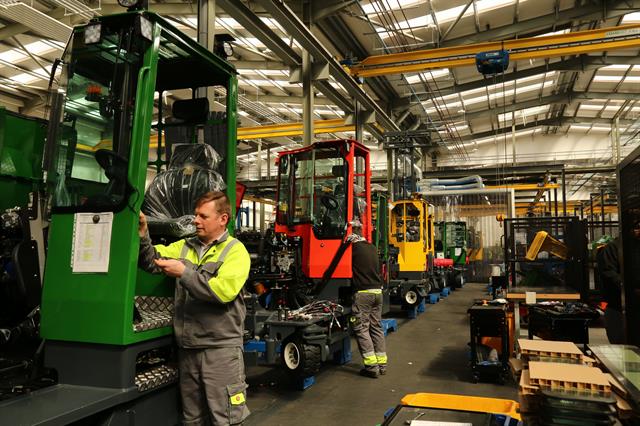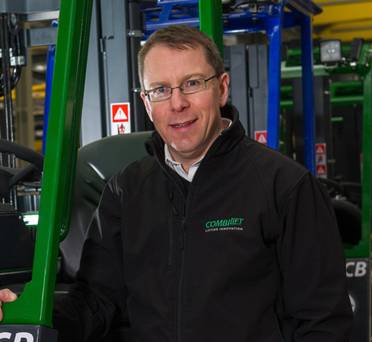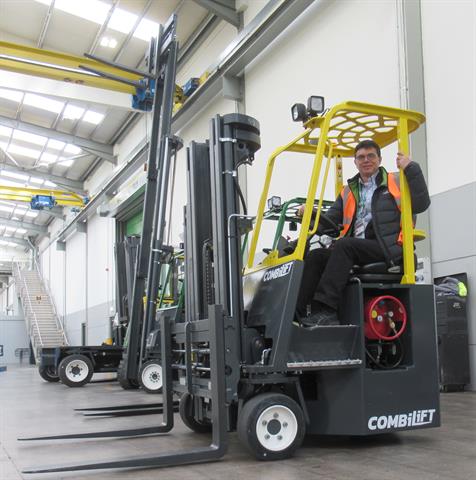 A production line at Combilift's 'new' facility |
By Allan LeibowitzPragmatism is a core concept at Combilift - from its growing range of specialised materials handling equipment to the design of the EUR50 million (USD56 million) plant which is coming up to its first anniversary.
The 46,500 sqm purpose-built factory is L-shaped, with the two production areas meeting at the central admin tower. The pragmatic design minimises the distance between production and design, research and development, testing, sales and marketing.
The fresh design and the extra space have allowed Combilift to double its output - and there's still room for expansion as demand increases.
"Our output last year was treble what it was before the 2008/9 downturn," says co-founder and managing director Martin McVicar. That's at a time when overall European materials handling production levels are only now starting to overtake pre-GFC levels, according to the German Mechanical Engineering Industry Association, VDMA.
Speaking in a glass-fronted meeting room towering over one of the production lines, McVicar attributes the growth to a combination of new products and new export markets.
 McVicar attributes growth to a combination of new products and new export markets. |
Those new products are designed to be pragmatic solutions to unique handling needs. "When we design a product, we don't want to develop it to be number two or three in that line: we want to be confident that we can become the number one player worldwide in the niche," he says. "So, I'm happy to develop products for a small niche because the smaller the niche, the easier it is to become the number one player."
He cites a new rough-terrain machine designed especially for the poultry market - a long way from the long-load handling equipment which characterised Combilift's first 10 years. Then, Combilift saw a gap in the warehouse market. "We weren't the first to make articulated forklifts, but I can confidently say we are the largest producer worldwide of that product," McVicar says. Again, pragmatism is the secret: "We developed a product that's reliable and easy to service," he says.
And that ease of servicing goes back to the production process. Rather than re-inventing the wheel, Combilift uses generally available parts, wherever possible. While this may involve forgoing parts revenue - which, for some competitors, can comprise 25% of revenue - it means parts are readily available anywhere in the world and the machines can often be serviced or repaired by "any capable mechanic".
Combilift's latest focus is on pedestrian models, culminating in the Combi Powered Pallet Truck (PPT), a pallet truck series capable of handling loads up to 16 T which is in the running for an
IFOY award.
With a limited domestic market in Ireland, Combilift has a clear focus on exports. Combilift currently exports 98% of its products to 85 countries and is understandably concerned about the
impact of Brexit. That concern is heightened by the fact that the UK accounts for 25% of the company's sales. But even with the looming exit from Europe, Combilift's UK sales for the first quarter of 2019 have been the highest for any quarter in its history.
At the same time, McVicar is buoyed by the opportunities in developing markets.
"We've been doing business in India for around 10 years, but when you're on the ground in India now, you feel that the economy is really growing. Companies are investing, they're building warehouses, there's e-commerce growth; so there's tremendous opportunities there," he explains.
Other growth markets for the Irish manufacturer include Brazil, China, Russia and South Africa.
 The editor and the forklift |
"Beyond that, we have doubled our business in North America in the last three years and we are confident we can double it again in the coming three years," he says. "And even if sales of traditional forklifts aren't growing there, we're confident that with the range of innovative products we're making, there's no reason we can't double our business."
While the product range aims at either saving space or increasing efficiency, McVicar sees safety as another driver, especially in the mature markets. "If you look at the models we bring to market, there's usually a unique safety feature," he notes - and that is often the major factor in purchase decisions.
Closer to home, in Europe, besides growing demand for warehouse efficiency, McVicar sees opportunities arising from the shortage of labour and the consequent move to prefabrication. "Components are getting bigger and more difficult to handle, and that creates opportunity for our equipment that can take big pieces through narrow factory doors and load them onto trucks."
"We're very optimistic. As long as there's not a world crash, there's no reason we can't double our business around the world," he concludes.
Established by McVicar and partner Robert Moffett in 1998, Combilift is a privately held company which now has around 45,000 units in operation around the globe.